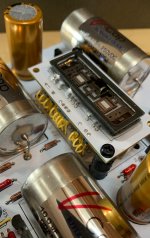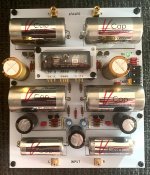So, here's a question -- kind of out there, but just wondering -- would there be longevity/stability advantages or disadvantages to changing the ON/OFF switch to switch only power to the filament instead of to the entire unit? If the cathode is cold then the tube is dormant, is that right? Where does the start/stop "thump" come from? Could it be avoided by leaving the unit powered except for the filament power? Wondering from a position of total ignorance . . .
So, here's a question -- kind of out there, but just wondering -- would there be longevity/stability advantages or disadvantages to changing the ON/OFF switch to switch only power to the filament instead of to the entire unit? If the cathode is cold then the tube is dormant, is that right? Where does the start/stop "thump" come from? Could it be avoided by leaving the unit powered except for the filament power? Wondering from a position of total ignorance . . .
Talk about getting it wrong -- just found an article at audioXpress, more than I needed to know, but the summary at the end gives the highlights and might be of interest if you want to understand the care and feeding of tubes.
The Internal Life of Vacuum Tubes | audioXpress
Wondering if I want to go the socket route when my replacement nuTube shows up. (Oh no! Another order from Mouser where I pay more for shipping than the parts.)
Thoughts? Suggestions for particularly good parts for this approach?
Might make the microphonics more of a problem, I suppose.
Thoughts? Suggestions for particularly good parts for this approach?
Might make the microphonics more of a problem, I suppose.
IMO, a socket is the only way to go. However, the NuTube socket and connecting header is difficult to source in US.
I would definitely treat the socket and NuTube leads with Cramolin. Assuming you can apply very tiny amounts, I would also use Silclear from Mapleshade Audio. I use it for interconnects and speaker cable interfaces (amp and speaker)and while it does not improve the sound after Cramolin cleaning, it keeps the connection from deteriorating due to oxidation. So no further cleaning is necessary after application. Without the Silclear, I had been cleaning my interconnects and speaker cable interfaces once a year.
I would definitely treat the socket and NuTube leads with Cramolin. Assuming you can apply very tiny amounts, I would also use Silclear from Mapleshade Audio. I use it for interconnects and speaker cable interfaces (amp and speaker)and while it does not improve the sound after Cramolin cleaning, it keeps the connection from deteriorating due to oxidation. So no further cleaning is necessary after application. Without the Silclear, I had been cleaning my interconnects and speaker cable interfaces once a year.
Last edited:
A little antioxidant goes a long way. I've had a 25mL bottle of Cramolin Red for over 30 years and still have some left.
It is now marketed as CAIG DeoxIT. Same stuff. I prefer the 100% red solution in the needle dispenser bottle:
https://amazon.com/CAIG-LABORATORIES-D100L-25C-Contact-Cleaner/dp/B0000YH6F8
It is now marketed as CAIG DeoxIT. Same stuff. I prefer the 100% red solution in the needle dispenser bottle:
https://amazon.com/CAIG-LABORATORIES-D100L-25C-Contact-Cleaner/dp/B0000YH6F8
I'm using something similar, it solved 95% of the microphonics.
Those and the silicone on the top completely stopped my microphonics on my B1K, but for my next build I did get one of the readily available riser boards that the chip mounts on and has extension wires back to the main board. I got the riser boards because the Korg overdrive guitar pedal I assembled not long ago used such an approach and I've never had any microphonics even with the pedal sitting right on top of my amplifier playing relatively loud. It seems that decoupling the tube itself from the rest of the circuit or chassis is the key.
--Tom
Thanks for sharing 🙂Those and the silicone on the top completely stopped my microphonics on my B1K, but for my next build I did get one of the readily available riser boards that the chip mounts on and has extension wires back to the main board..It seems that decoupling the tube itself from the rest of the circuit or chassis is the key.
--Tom
here is the complete board.
Such a beautiful
 B1K
B1K 
Waiting for music quality descriptions 😀 Congratulations
Edit: what is volume potentiometers ?
- Home
- Amplifiers
- Pass Labs
- B1 with Korg Triode


